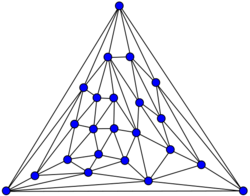Kittell graph
From HandWiki
In the mathematical field of graph theory, the Kittell graph is a planar graph with 23 vertices and 63 edges. Its unique planar embedding has 42 triangular faces.[1] The Kittell graph is named after Irving Kittell, who used it as a counterexample to Alfred Kempe's flawed proof of the four-color theorem.[2] Simpler counterexamples include the Errera graph and Poussin graph (both published earlier than Kittell) and the Fritsch graph and Soifer graph.
References
- ↑ Weisstein, Eric W.. "Kittell Graph". http://mathworld.wolfram.com/KittellGraph.html.
- ↑ Kittell, Irving (1935), "A group of operations on a partially colored map", Bulletin of the American Mathematical Society 41 (6): 407–413, doi:10.1090/S0002-9904-1935-06104-X, https://projecteuclid.org/journals/bulletin-of-the-american-mathematical-society/volume-41/issue-6/A-group-of-operations-on-a-partially-colored-map/bams/1183498239.pdf
 |


